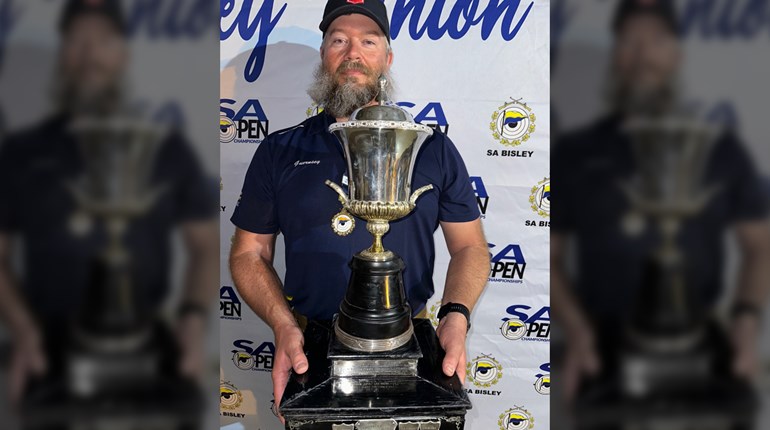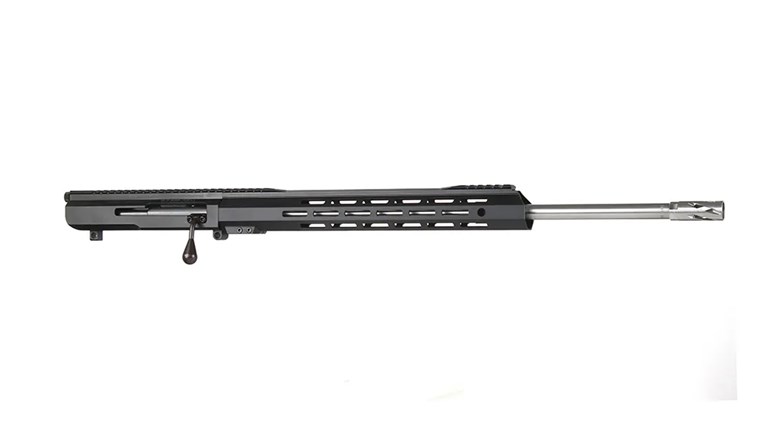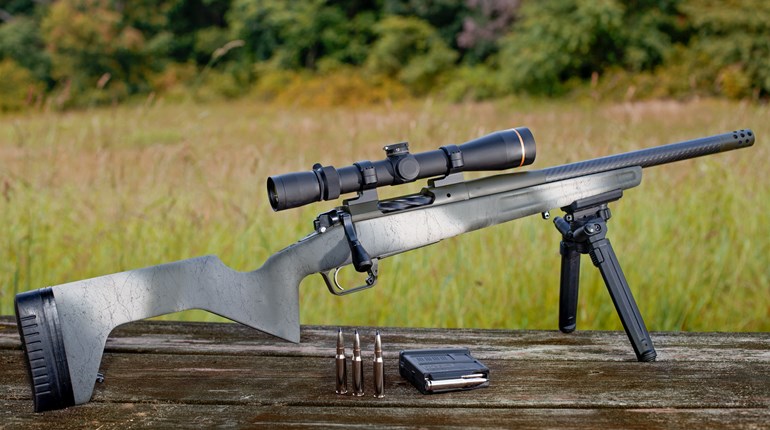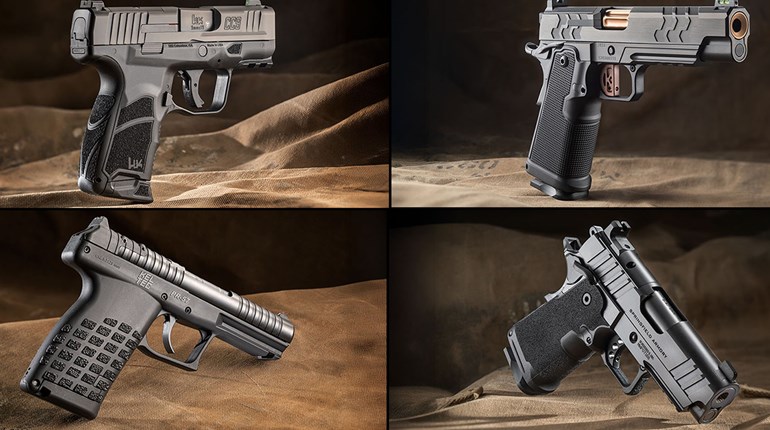
It seems like every possible advantage has to be offset by a matching relative disadvantage—a frustrating variation of Newton's third law. Nowhere did this seem to be truer than in the realm of precision rifles, where there has been the long-held belief by many that shooters must choose between extreme accuracy or fast follow-up shots—never getting both in one package. For those, the traditional bolt-action rifle was the source of the greatest accuracy while semi-automatics were simply a compromise in performance for a faster rate of fire.
However, over the years this perception has changed, with many capable semi-automatic designs proving you could have the best of both worlds. In a sense, the Army's new 7.62x51 mm M110 SASS (semi-automatic sniper system), which was developed to supersede the bolt-action M24, is a tacit acknowledgement of this reality. In fact, the M110 continues the military's tradition of semi-automatic precision rifles such as the M1C, M1D and M21.
Changing Perceptions
The procurement program for the SASS by the U.S. Army caused quite a stir in the firearms community, encouraging many manufacturers to focus on developing specialized variants of established semi-automatic rifle platforms. As a result, there was soon a growing genre of highly accurate semi-automatic rifles on the market.
It should come as no surprise that FNH-USA, the U.S. subsidiary of the Belgian FN Herstal company and a name ubiquitous in the tactical realm, would also add its own unique offering to this growing market. And, although this new rifle was not part of the SASS program, it neatly fits within this increasingly popular genre.
This new rifle, the FNAR, is a semi-automatic 7.62x51 mm precision rifle designed to offer great performance at a higher rate of fire than a comparable bolt-action rifle. The FNAR's designation, which stands for "FN Automatic Rifle," may at first seem to be a bit of a misnomer as it is a semi-automatic rifle, but it makes sense once you understand the basis of the design.
While FN Herstal has its own line of respected proprietary firearm designs, it also understands and fully utilizes the strengths of its subsidiary companies. For example, FN bolt-action rifle lines, including the SPR (special police rifle), PBR (patrol bolt rifle) and PSR (precision shooting rifle) lines, are based off of the respected Model 70 from Winchester, one of FN's subsidiaries. FN has also developed several fine shotgun offerings from Winchester designs.
By the same token, when FNH-USA decided to develop a semi-automatic precision rifle, it looked closely at its holdings and saw a particular design with a lot of potential for this project—the Browning BAR. The BAR, which stands for Browning Automatic Rifle, is a semi-automatic sporting rifle design that shares the same model designation with the John Moses Browning-designed Browning Automatic Rifle of World War I, World War II and Korean War fame.
A Solid Foundation
The Browning BAR, a popular sporting rifle design, is unique in that it is one of only a few traditional semi-automatic sporting rifles on the market. Chambered in broad range of powerful chamberings, the BAR has a proven record of ruggedness and accuracy—making it a logical choice for the project. While the new BAR and the original BAR share the same name and some general similarities in appearance, mechanically they are quite different.
As opposed to the select-fire military BAR, the new BAR is a semi-automatic-only design. It features a short-stroke gas-piston operating system and a seven-lugged rotating bolt that locks into an extension of the stressed-steel barrel. This allows the rifle to employ a lightweight 7075-T6 anodized-aluminum receiver.
The BAR's short-stroke gas piston system employs a gas-tapping hole roughly 9 inches down the barrel from the forward part of the receiver that diverts gases into the gas system. The gas system is made up of a short-stroke piston and an inertia block. As a cartridge is fired, gas is directed through the gas port down into the gas system. This force operates the short-stroke piston that in turn imparts movement to an inertia block, which is attached to the bolt carrier assembly by dual action bars.
The mass of the inertia block, driven by the force of the piston, drives the bolt carrier assembly rearward, which rotates and unlocks the multi-lugged bolt from the barrel extension. Continued rearward movement extracts and ejects the fired case, while the spring-driven bolt-carrier assembly strips a new round out of the magazine and feeds it into the chamber during its forward movement. The bolt features a Sako-style pivoting extractor and a plunger ejector.
For obvious reasons, the Browning BAR made a sensible choice for FN as the basis of a new semi-automatic precision rifle. However, the sporting configuration offered by Browning did not exactly fit the needs of FN, which set about tweaking and modifying the design to fit its specific requirements.
A Jungian Take
The FNAR that resulted from the project is unique. Rather than being a long-barreled, heavyweight precision rifle, it instead seems to be more of a tactical rifle/precision rifle hybrid. With its 20-inch barrel and a weight of around 9 to 10 pounds, the FNAR has an almost dual-use approach. Although it is by no means a short-barreled "entry" rifle, its size and weight is in line with that of other full-sized standard 7.62x51 mm rifles such as the M1A/M14, the FAL or the HK91/G3 rifles.
So what exactly is the FNAR, and how does it differ from its sibling, the Browning BAR? The FNAR is offered in two configurations—the standard "light" version with an overall weight of 8.25 pounds without magazine and a muzzle diameter of 0.745 inch and the "heavy" variant, which weighs in at 9.25 pounds and has a muzzle diameter of 0.765 inch. Both versions' barrels are of chrome-moly steel and feature hard-chromed bores for longevity and durability. The exterior of the barrels feature longitudinal flutes and a manganese-phosphated finish. The muzzles are topped off with a recessed target crown.
To take full advantage of all the barrels' potential accuracy, the FNAR's alloy receiver is drilled and tapped and fitted out with a strip of T6 aluminum M1913 Picatinny rail to accept optics. Another tweak to the receiver area is a red dot located on the upper face of the lower edge of the ejection port. This red dot is intended to act as a reference point relative to the location of the operating handle, indicating whether or not the action is fully in battery.
Another area of significant change from the BAR is in the rifle's feeding device. Whereas the original BAR has a hinged floorplate that conceals a box magazine, the limited ammunition capacity of this design was an issue for FN designers. As a result, the FNAR was designed to employ a proprietary detachable magazine available in 10- and 20-round capacity versions. The magazine is solidly built from steel. The polymer follower is made of two pieces and is attached to the spring by a screw located in its forward upper face.
To accommodate this newly designed magazine, a magazine block that fits up into the bottom of the receiver was developed. This block of T6 aluminum features ambidextrous controls, with a round, knurled button release on the right side and a large, square-shaped knurled button on the left side.
Apart from the magazine-release buttons on the newly designed magazine block, the controls of the FNAR are quite similar to that of the BAR. A simple crossbolt push-button safety is located in the rear portion of the triggerguard, with a red ring around its left side to indicate the rifle is "off" safe. This is reversible for left-hand use by a qualified gunsmith. A grooved bolt-lock lever is located on the forward portion of the right side of the receiver, extending out from under the handguard. This lock can be used to release the bolt and chamber a round as well as to manually lock the action open. It is automatically engaged by the follower of an empty magazine. On a related note, the FNAR's steel magazine has a large open cut out on its right side to allow the follower to engage the bolt lock. Care should be taken to ensure that foreign material is not allowed to enter the magazine through this opening.
The Everyman's Rifle
The differences between the FNAR and the BAR are not just strictly mechanical. A great deal of thought was put in by FN toward modifying the ergonomics of the platform to make it more suited toward a tactical/precision rifle role. For obvious reasons, this effort focused on the buttstock and fore-end of the rifle.
One of the most visually striking differences from the BAR to the FNAR is the configuration of its buttstock. Unlike the traditionally curved pistol grip stock of the BAR, the FNAR sports a one-piece, pistol-gripped synthetic stock. Of note is the fact that the shape and size of the grip and buttstock were purposely designed around the dimensions of an AR-pattern rifle, making for a simpler transition for those accustomed to that type of firearm. Although not exactly the same configuration, the FNAR's magazine-release button is in the generally the same location as that of an AR-pattern rifle.
FN attempted to carry over some of the modular adaptability of the AR-type buttstock—although from quite a different approach. In the interest of making the FNAR stock's fit customizable to the broadest range of shooters possible, the FNAR employs a host of customizable features.
One feature carried over from the BAR is a replaceable stock-shim system. The FNAR comes with a set of six replaceable shims that fit in the joint between the buttstock and the receiver. The shims are designed to adjust comb and heel drop as well as the cast of the stock.
The first three adjust comb and heel drop. Shim 1 raises the comb approximately 1⁄16 inch and the heel 1⁄8 inch. The shim that comes installed on the rifle, number 2, is neutral. Shim 3 lowers to comb approximately 1⁄16 inch and the heel 1⁄8 inch.
Shims 1R1L, 2R2L and 3R3L adjust the cast, as well as the drop of the comb and heel. To adjust cast to the left or right approximately 1⁄8 inch, each of these has an "L" on one side and an "R" on the other. For "cast on" (left), install the shim with the "L" facing the butt of the stock. For "cast off" (right), install the shim with the "R" facing the butt of the stock.
In addition to the dizzying list of comb and heel drop and cast adjustments, the FNAR's stock is also adjustable for length of pull through the use of three included interchangeable recoil pads. They include a short recoil pad that is 1⁄2 inch thick, a medium recoil pad that is 3⁄4 inch thick (which comes installed on the rifle), and a long recoil pad that is 1 inch thick. All that is required to change them is a screwdriver.
The FNAR also offers an adjustable comb-height system with three included interchangeable, rubber-overmolded comb pads. Easily interchangeable with the use of screwdriver, they come in three heights (low, medium and high) with 8 mm height differences between each of them. The rifle comes from the factory with the medium-height comb pad installed.
The synthetic fore-end of the FNAR also received some attention over that of the standard BAR. To allow users the opportunity to fit out the FNAR with a host of additional accessories such as bipods, lights and lasers, the forward section of the fore-end has three sections of Picatinny rail attached in the 3 o'clock, 6 o'clock and 9 o'clock positions (when viewed from the front).
Precision in Focus
The fit and finish of the FNAR is superb, as should be expected from FNH-USA. The alloy receiver features an evenly applied matte-gray anodized finish that matches exceptionally well with the gray color of the manganese-phosphate finish on the steel parts. The action in the test rifle cycled smoothly by hand, and the all controls worked positively. The 20-round magazine included with the rifle is solid and substantial, and locked soundly into place in the magazine block. Both of the ambidextrous magazine-release buttons worked positively.
For testing, I outfitted the FNAR with a Leupold Mark 2 3-9x40 mm scope and mounted it with Brownells steel rings. Despite all the adjustments available with the stock, I ultimately decided the factory configuration suited me best. With that, I headed to the range with the rifle, several types of ammunition and a new Champion folding target holder (www.championtarget.com) I have been testing.
For the first few boxes of ammunition, the FNAR was having some malfunctions early in a fully loaded magazine. However, after several boxes of ammunition this cleared up. After conferring with FN on the matter, we determined that this was likely caused by some packing grease that I had neglected to clean out of the rifle thoroughly enough before my range session.
I tried the rifle with a selection of Black Hills, Federal, Hornady and Remington ammunition. With the Hornady 168-grain TAP ammunition, I had blown out primers with roughly a third of the ammunition. All the other ammunition on the other hand performed without problem. Once I began looking closely at the shooting results, I recognized the FNAR is astoundingly accurate, as is shown in the accompanying shooting results. Also, I found the rifle to be extremely pleasant to shoot, offering the softest perceived recoil I have experienced from any .308 Win.




































